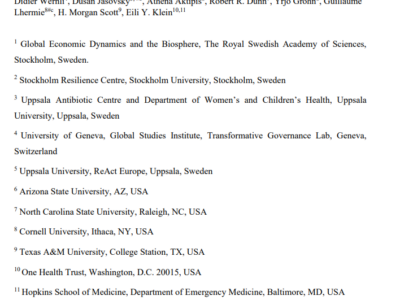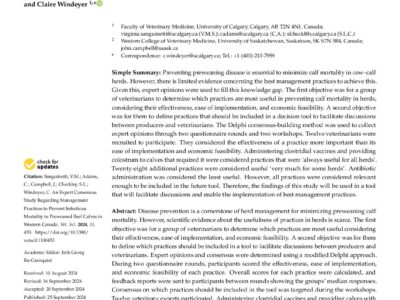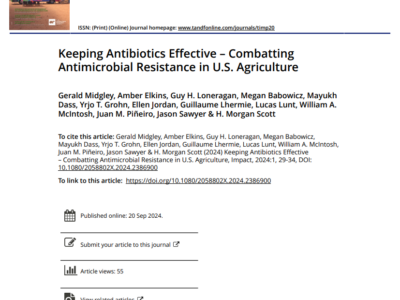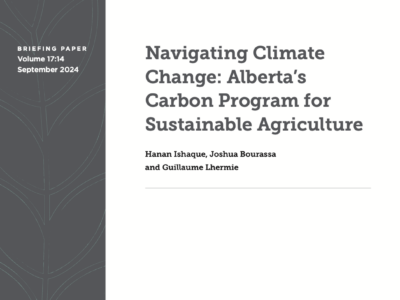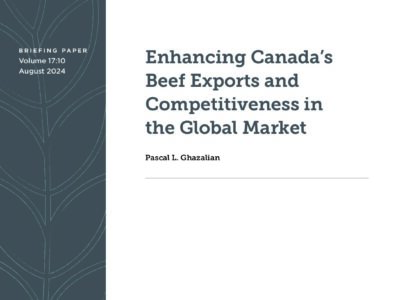Publications
Background: The world’s governments have agreed both global and national actions to address the challenge of antimicrobial resistance. This raises the importance of understanding to what degree national action so far has been effective. Answering this question is challenged by variation in data availability and quality as well as disruptive events such as the COVID-19 pandemic. We investigate the association between a survey of self-reported action based on the first Global Database for Tracking Antimicrobial Resistance (TrACSS) survey and trends in multiple indicators related to the DPSEEA framework leading up to the survey. Methods and findings: We apply regression methods across 73 countries between actions in 2016 and the trend in indicators of health system development (drivers), antibiotic use (pressures, ABU), absolute rates of resistance (state, ABR) and relative rates of resistance (exposure, Drug Resistance Index, DRI) from 2000 to 2016. We find that action is consistently associated with improved linear and categorical trend in health systems, ABU, ABR and DRI. Reductions are associated with relatively high levels of action (0-4) for ABU (median 2.8, 25-75% quartile 2.6-3.3), ABR (3.0, 2.4-3.4), and DRI (3.5, 3.1-3.6). These associations are robust to the inclusion of other contextual factors such as health system and socio-economic status, human population density, animal production and climate. Since 2016, a majority of both Low-Middle Income Countries (LMICs) and High-Income Countries (HICs) report increased action on repeated questions, while one third of countries report reduced action. The main limitations in interpretation are heterogeneity in data availability and the recency of action. Conclusions: Our findings highlight the importance of national action to address the domestic situation related to antibiotic resistance and indicate the value of both incremental changes in reducing adverse outcomes and the need for high levels of action in delivering improvements.
Thursday, September 26, 2024
Peter Søgaard Jørgensen, Luong Nguyen Thanh, Ege Pehlivanoglu, Franziska Klein, Didier Wernli, Dusan Jasovsky, Athena Aktipis, Robert R. Dunn, Yrjo Gröhn, Guillaume Lhermie, H. Morgan Scott, and Eili Y. Klein
Disease prevention is a cornerstone of herd management for minimizing preweaning calf mortality. However, scientific evidence about the usefulness of practices in herds is scarce. The first objective was for a group of veterinarians to determine which practices are most useful considering their effectiveness, ease of implementation, and economic feasibility. A second objective was for them to define which practices should be included in a tool to facilitate discussions between producers and veterinarians. Expert opinions and consensus were determined using a modified Delphi approach. During two questionnaire rounds, participants scored the effectiveness, ease of implementation, and economic feasibility of each practice. Overall scores for each practice were calculated, and feedback reports were sent to participants between rounds showing the groups’ median responses. Consensus on which practices should be included in the tool was targeted during the workshops. Twelve veterinary experts participated. Administering clostridial vaccines and providing calves with colostrum in case they had not nursed were considered practices that were ‘always useful for all herds’. However, most practices had intermediate levels of usefulness, and among these, antibiotics were considered the least useful. Nevertheless, all practices discussed during the workshops attained a consensus about being included in the future tool to facilitate on-farm discussions.
Wednesday, September 25, 2024
Virginia Margarita Sanguinetti, Cindy Adams, John Campbell, Sylvia L. Checkley, and Claire Windeyer
Antimicrobials are medicines that are designed to kill a variety of organisms, most notably disease-causing bacteria. They include antibiotics and other anti-bacterial substances. Unfortunately, bacteria may develop resistance to antimicrobials, and this poses a major threat to human health in the 21st Century: the discovery of new antimicrobials has slowed down, but resistance to existing ones is continuing to increase. If antimicrobials lose their effectiveness, millions of people will die from illnesses that can currently be treated. Any use of antimicrobials can stimulate resistance if the context enables resistant bacteria to multiply at the expense of non-resistant ones. The over-prescription and misuse of antimicrobials increases the likelihood of resistance spreading, so this needs to be tackled by public health systems. Unfortunately, this is not just a problem for human health: antimicrobials are also prescribed to food animals (like cows, pigs, sheep and chickens), and some antimicrobial resistant bacteria can move between animals and people. Antimicrobial resistance (AMR) in agriculture therefore poses a double risk to humans: reduction in the effectiveness of antimicrobials and disruption to food security. The over-prescription and misuse of antimicrobials increases the likelihood of resistance spreading, so this needs to be tackled by public health systems.
Friday, September 20, 2024
Gerald Midgley, Amber Elkins, Guy H. Loneragan, Megan Babowicz, Mayukh Dass, Yrjo T. Grohn, Ellen Jordan, Guillaume Lhermie, Lucas Lunt, William A. McIntosh, Juan M. Piñeiro, Jason Sawyer, and H. Morgan Scott
In 2021, the Government of Alberta launched the carbon program initiative to evaluate environmental practices and greenhouse gas reduction strategies in the agricultural sector. The program has produced various technical reports, policy briefing papers, industry surveys and roundtables. This policy paper consolidates the findings of the research. It presents an analysis of Alberta’s greenhouse gas emission profile, historical trends and the policy framework, as well as an examination of mitigation strategies such as carbon pricing and their effectiveness in Alberta’s agricultural system. The key question addressed in this paper is how Alberta can continue to support its thriving agricultural industry while responding to the federal and global calls to significantly reduce its methane and nitrous oxide emissions and fulfil Canada’s climate commitments. The paper also outlines the obstacles that producers encounter when implementing these strategies, as well as the limitations of the current emission estimation methodology in measuring the impact. To effectively address the challenges of emission mitigation in Alberta’s agriculture sector, a co-ordinated approach at both the federal and provincial levels is crucial. The paper concludes with the following recommendations that outline specific actions to help reduce uncertainties and support producers in implementing best management practices (BMPs) to lower greenhouse gas emissions.
Wednesday, September 18, 2024
Hanan Ishaque, Joshua Bourassa and Guillaume Lhermie
The Bellagio Group for Accelerating AMR Action met in April 2024 to develop the ambitious but achievable 1–10-100 unifying goals to galvanize global policy change and investments for antimicrobial resistance mitigation: 1 Health; 10 million lives saved; and 100% sustainable access to effective antimicrobials. High profile political goals such as the Paris Agreement’s objective to keep global warming well below 2° Celsius compared to pre-industrial levels, UNAIDS’ 90–90-90 goal, and the Sustainable Development Goals challenge global norms, direct attention towards relevant activities, and serve an energizing function to motivate action over an extended period of time. The 1–10-100 unifying goals propose to unite the world through a One Health approach to safeguard human health, animal welfare, agrifood systems, and the environment from the emergence and spread of drug-resistant microbes and infections; save over 10 million lives by 2040 through concerted efforts to prevent and appropriately treat infections while preserving the vital systems and services that depend on sustained antimicrobial effectiveness; and commit to ensuring that antimicrobials are available and affordable for all, used prudently, and secured for the future through innovation. Compared to existing technical targets, these unifying goals offer advantages of focusing on prevention, encouraging multisectoral action and collaboration, promoting health equity, recognizing the need for innovation, and integrating with Sustainable Development Goals. By committing to 1 Health, 10 million lives saved, and 100% sustainable access to effective antimicrobials, we can protect lives and livelihoods today and safeguard options for tomorrow.
Source: Globalization and Health
Tuesday, August 27, 2024
Susan Rogers Van Katwyk, Mathieu J. P. Poirier, Sujith J. Chandy, Kim Faure, Caitlin Fisher, Guillaume Lhermie, Arshnee Moodley, Satyajit Sarkar, Masika Sophie, Kayla Strong, Isaac Weldon, and Steven J. Hoffman
This study aims to provide a policy brief on Canada’s beef and cattle production and exports, and international market access and conditions. Trade barriers are identified and evaluated, and the implications of non-tariff measures (NTMs) are examined. These include, for example, the ban imposed by the European Union and the United Kingdom on the importation of peroxyacetic acid (PAA)-treated and hormone-treated beef, and the United States’ political/legislative attempts to invoke the mandatory country-of-origin labelling (CoOL) standard for Canada’s beef exports.
This study also discusses the benefits and limitations of preferential trade agreements (PTAs) for Canada’s beef exports, such as the Canada-U.S.-Mexico Agreement (CUSMA); the Canada-EU Comprehensive Economic and Trade Agreement (CETA); and the Comprehensive and Progressive Agreement for Trans-Pacific Partnership (CPTPP). The study concludes by exploring the opportunities to increase Canada’s beef exports and competitiveness in international markets.
Wednesday, August 07, 2024
Pascal L. Ghazalian
- 1
- 2
- 3
- …
- 12
- Go to Next Page

